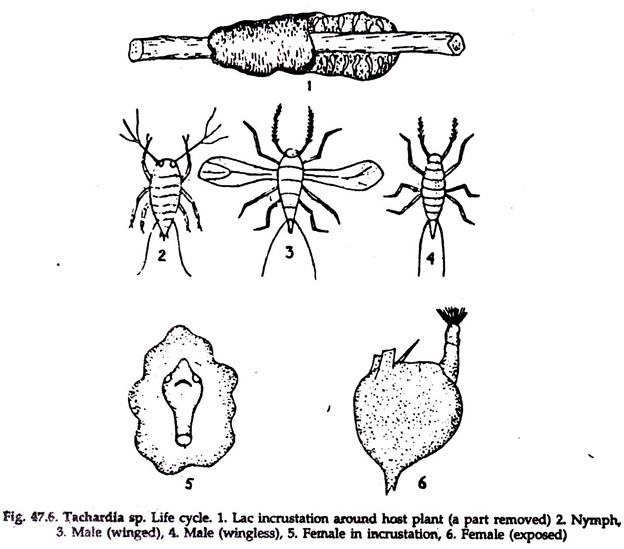In this article we will discuss about:- 1. Meaning of Lac Culture 2. Types of Lac 3. Life Cycle of Lac Insects 4. Harvesting and Extraction 5. Uses of Lac 6. Enemies.
Meaning of Lac Culture:
Lac culture is the scientific management of lac insects to obtain a high amount of quality lac. This involves selection and maintenance of host plants, inoculation of host plants with healthy lac insects, collection and processing of lac and protection against enemies.
Lac is the resinous secretion of lac insects. Two species of lac insects Tachardia lacca and T. chinensis are common, of which the former one is predominant in India. India is the highest lac-producing country. Thailand is next in order.
Host plants:
ADVERTISEMENTS:
Kusum, Ranjeeni (Khair) and Ber (Plum) trees. The insects live upon plant juice.
Inoculation:
20 to 30 cm long twigs of host plant with old lac crusts are cut and tied with branches of new plants for propagation. The crust contains eggs laid by female insects.
Types of Lac:
1. Kusmi lac:
ADVERTISEMENTS:
It grows on Kusum trees. Inoculation is done in January-February and harvested in June-July.
2. Ranjeeni lac:
It grows on trees other than Kusum. Inoculated in October-November and harvested in next May-June.
Life Cycle of Lac Insects:
A resinous exudate comes out of the insect body and forms a crust around it, which gets attached to the host plant. Gradually a thick crust of the resinous substance or lac surrounds the twig.
ADVERTISEMENTS:
1. Following inoculation, the larvae hatch out of the eggs present in the old crust. They are nymphs and come out of the crust. This is swarming (Fig. 47.6).
2. The abandoned old crust is called Phunki.
3. The phunki is removed within three weeks of inoculation.
4. The nymphs are boat-shaped, reddish in colour and possess one pair of antennae, three pairs of thoracic walking legs and a pair of caudal setae.
5. Some of the nymphs are males—both winged and wingless, and others are females.
6. The nymphs move to new branches of the host plant. With the help of maxillae and mandibles modified for sucking, they suck cell sap from the branches of the host plant to thrive. The nymphs settle on the branch and liberate the exudate.
7. Most of the body structures are lost and the nymphs moult several times.
8. The rejected skin and the exudate form a crust around it containing a pair of branchial pores and a large anal tubercular opening.
9. An operculum is present at the tubercular opening. The male comes out removing the operculum after three months.
ADVERTISEMENTS:
10. The male copulates with female. The males are devoid of mouth parts and die soon after mating. The female lays eggs in the crust.
Harvesting and Extraction of Lac:
1. Twigs with thick crusts around it are cut and removed from sites.
2. The incrustations are scraped out from the twigs. This is granular lac.
3. The granular lac is thoroughly washed with water. A red ‘dye is obtained in the process. Drying and bleaching of washed lac are done by exposure to sunlight.
4. The granules are melted in pot over open charcoal fire.
5. The lac melts and comes out of the crust. Hun sheets are prepared from the molten lac. The sheets are dried and broken into pieces and marketed as flakes.
Uses of Lac:
Lac is used in the manufacture of toys, ornaments, electrical insulating materials, varnishes, polishes, lithographic inks, shoe polishes, sealing wax, etc.
Enemies of Lac:
Some chalcedonic and lepidopteran insects lay eggs inside the mists. The nymphs of lac insects are eaten up by their larvae.
Proper selection of seed lac, killing of predator eggs in harvested lac, and use of insecticides greatly minimise damage to the crop.
